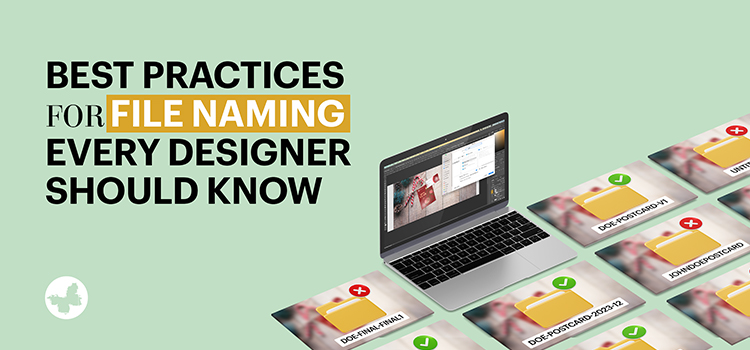There are several significant applications for file naming, particularly in the fields of design and marketing. Although most graphic designers already understand the significance of naming files in a specific way, most of them don’t implement a proper naming convention approach. There is a difference between knowing and doing.
Having a clear file naming system will help you find your projects more easily and keep everything organized. One of the best ways to create an easy-to-use and efficient file system is by having a strong set of file naming rules. This article helps you understand the best file naming conventions, with a focus on the proper format of file names with examples, for B2B wholesale printing.
Read More: How to Prepare Your Design for Printing
Contents
File Naming Conventions in Wholesale Printing

File naming conventions are the agreed-upon methods to name files. These are designed to make it simpler to determine the purpose, contents, and owner of a file based on its name. A crucial component of a productive print project is having a consistent, unambiguous file name system to simplify and classify your files and tasks. This will save you time when trying to find a specific file.
Using a file naming convention is important for lots of reasons. Let’s take a detailed look at these reasons for managing your files better, helping you understand these practices better.
- Put Searchability First: To make searching and finding your files easier, start the file name with the most important information (such as the client’s name). Then add other shortened specifics, which are the most important ones for you.
- Simple File Names: Don’t use long names, but use words that tell you what’s in the file. Stick with basic stuff like numbers and letters. Skip spaces in the file names. Use stuff like underscores or hyphens to break up words. This can help you find and recognize files faster and easier.
- Use Identifiers: Add a short name or code for the project or customer in your file names. This makes it faster to find the file you need. The short name can be the first few letters of your client’s name or a word that stands for the project’s name. By doing this, you’ll have an organized and efficient way to track your files, saving you time and effort.
The elements of the file name should be understandable for everyone. Using a code language that you only know will not help you. Using short but obvious names with relevant abbreviations will be the perfect method.
Read More: Preparing Print Files: 5 Simple Steps to a Successful Print
File Naming Conventions for Businesses

While creating your design file for wholesale print, you may need to make some changes to the files, saving the new version. So, it’s really important to name your files in a clear and brief way. This means everyone must be able to understand your file naming system. If the print partner cannot differentiate which file belongs to what product or date, the whole print process will be more complicated and time-consuming. To understand this procedure better, let us talk about the exact guidelines businesses should keep in mind for file naming conventions:
Name of Client or Project
The naming should start with the specific client or project/product. This will make it easy to find files for the print company. If it is for you, add your name’s abbreviation. If you are designing for another business, start the file name with the client’s or brand’s name.
Date of Creation or Delivery
Sometimes, putting the date in your file names can be a good idea. This is handy whether you need to know when the file was first created or the wholesale printer wants to know when the deadline or start date is. As is common in many digital systems, it is advised to use the (YYYY-MM-DD) format so that files sort chronologically.
Use Versions
Putting version numbers in your file names is helpful. It’s especially good when you are working on different design steps or team projects. It makes it easy to see how far you’ve come and to make sure everyone is using the latest file. By doing this, nobody gets confused about which file to use, and you can track how your work is going.
Add Details of Product/Design
Add a code or short name for the product/item or file format. This helps in quickly identifying files and keeping everything organized. To guarantee simple detection and effective file management, keep file names brief but descriptive.
The final file name should be like this:
ButterflyGP_Brochure-FallCampaign_2025-09-10_V3.JPEG
Tips to Simplify the File Naming for Wholesale Print

- Avoid Using Spaces: Since spaces can cause problems in different operating systems, use underscores (_) or hyphens (-) to separate words or components while file naming.
Be Consistent: Name all the files the same way every time. This is a key factor in staying supervised. Find a style that works well for you and your print partner, and don’t change it. Always adhere to your unique file naming system. - Avoid Using Characters: Special characters, such as @, #, $, %, &, or ?, should be avoided as they may lead to issues. Certain operating systems do not support certain characters, while others are only used for particular purposes. Such characters can cause file paths to become ambiguous, making it challenging to find or decipher the true location of the file.
- Use Standard File Type: Always end the file name with the file extension (e.g., .pdf, .tif, .jpg). It facilitates the proper recognition and opening of files by operating systems and software programs. This serves as a descriptor, identifying the format of the file and the application required to view its contents.
- Training: Teach everyone on your team about the naming rules for files. The more people know, the better they can stick to the rules. By getting everyone on the same page and understanding the system, your team can work more efficiently and reduce the chance of problems caused by misnamed or lost files.
Conclusion
Following a good file naming convention is important for managing things smoothly in both design and business. It may take some time and patience to set up, but the payoff is huge. More work gets done, people are less stressed, and everyone can work together easily. Even though it might not seem like a big deal, how you name your files is powerful because it’s key to turning a messy file system into an organized one.
No matter what industry you’re in, consult with an expert wholesale print partner and ask about their file naming conventions to boost the flow of work. You can always contact ButterflyGP.com to ask your questions about file naming before starting your bulk order for all the print products you need for marketing.
